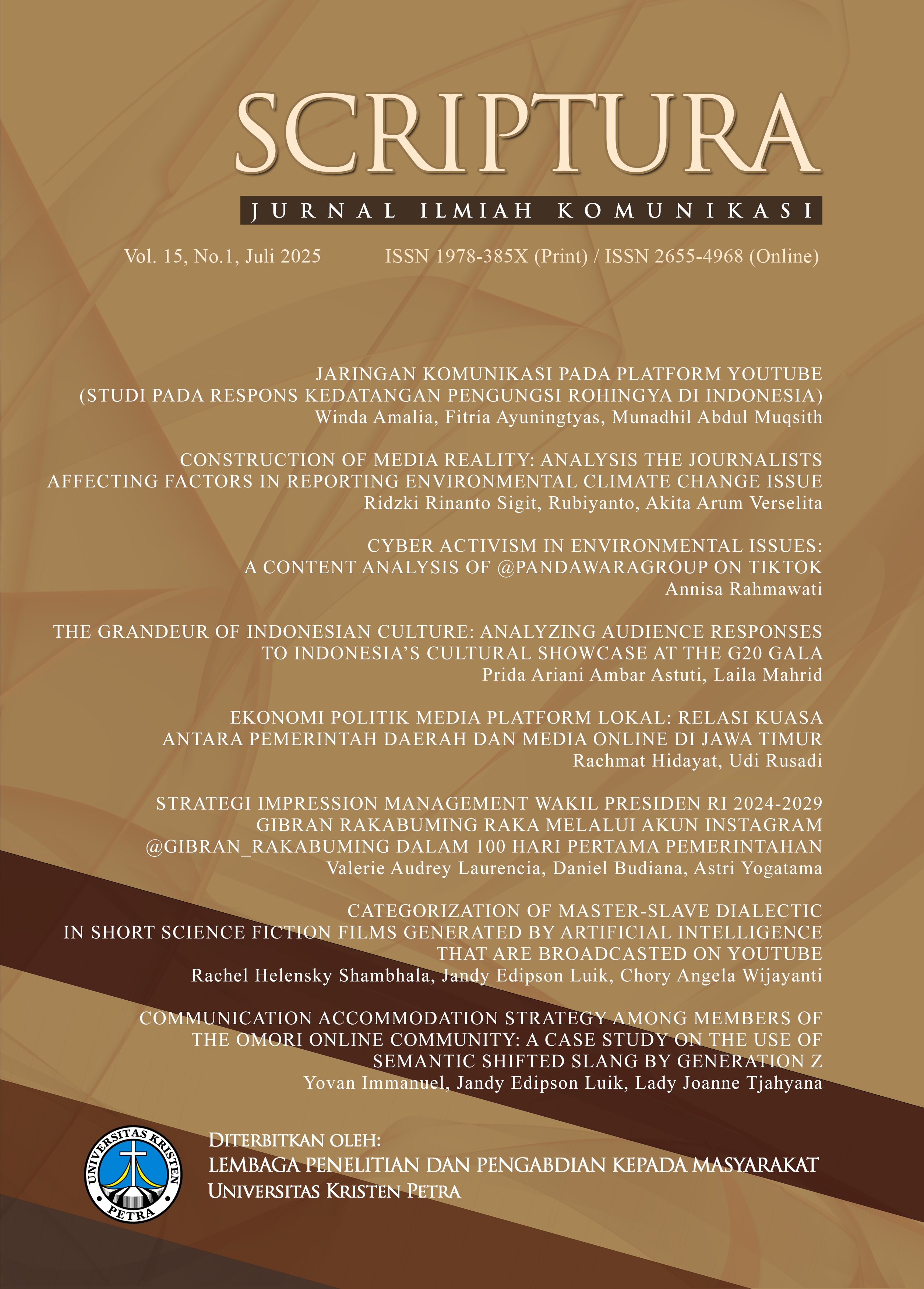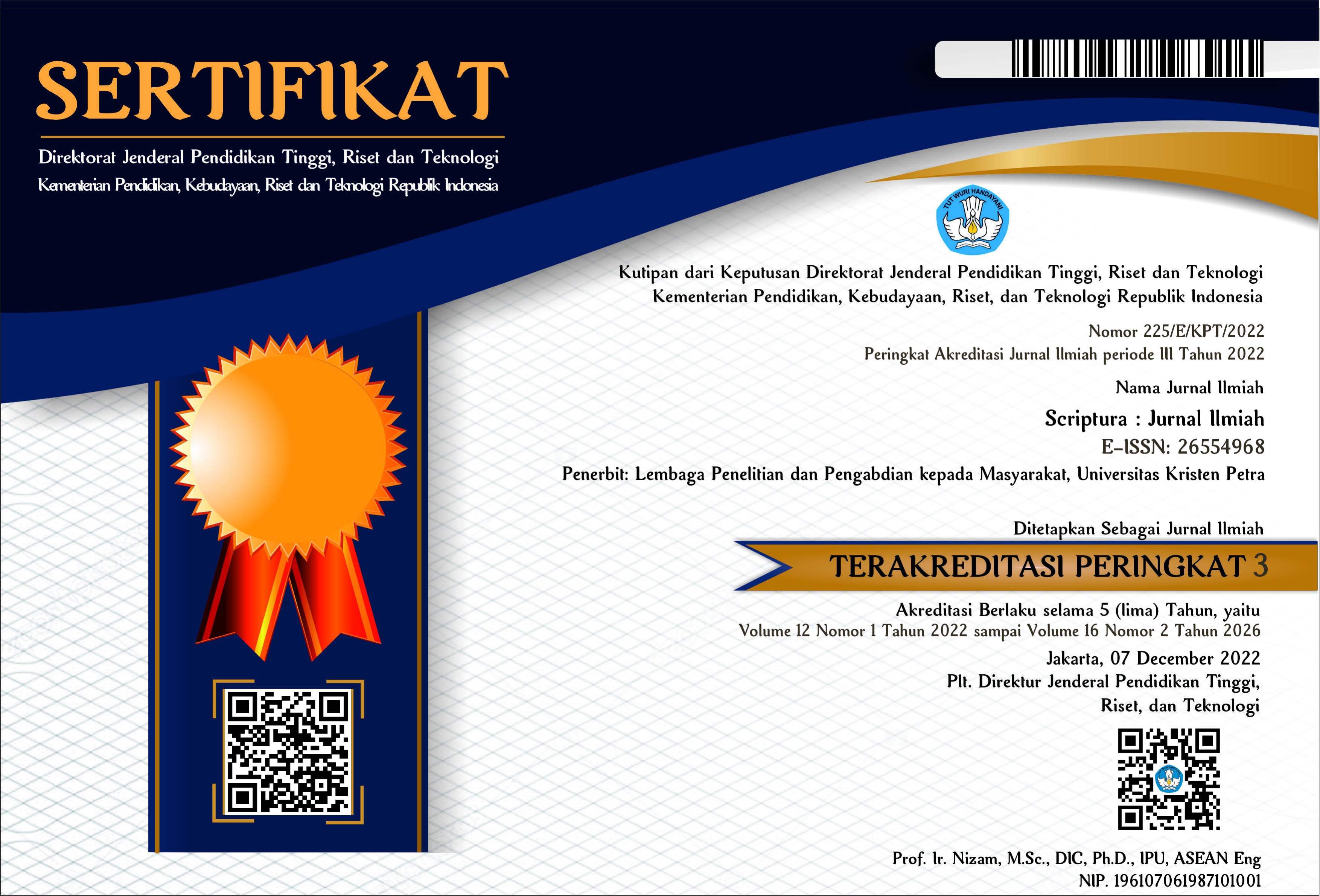Categorization of Master-Slave Dialectic in Short Science Fiction Films Generated by Artificial Intelligence That are Broadcasted on YouTube
DOI:
https://doi.org/10.9744/scriptura.15.1.84-94Keywords:
categorization, master-slave dialectic, short film generated by AI, short science fiction film, qualitative content analysisAbstract
The rapid evolution of artificial intelligence (AI) has transformed the creative industry, enabling machines to generate images and videos that can be compiled into narrative short films. This technological shift raises important questions about authorship, control, and meaning-making in digital media. This study aims to investigate how the master-slave dialectic, a philosophical concept describing power dynamics between entities, is portrayed in AI generated science fiction short films. Using qualitative content analysis, 10 AI generated short films were examined to identify how messages related to this dialectic are communicated. The analysis reveals three major categories, vulnerability, alienated, and automation. With vulnerability and automation being most prominently depicted, while alienated appears more subtly. Across these categories, eight subcategories were identified, including two new ones which are acceptance and rebellion, that extend Coeckelbergh’s framework and reflect diverse human responses to technological dominance. These results demonstrate that AI generated films can convey complex socio-technical tensions and function as an emerging form of mass communication, contributing to the discourse on human and technology relations in contemporary media.
References
Badet, J. (2021). AI, Automation, and New Jobs. Open Journal of Business and Management, 9, pp.2452–63. https://doi.org/10.4236/ojbm.2021.95132.
Coeckelbergh, M. (2015). The Tragedy of the Master: Automation, Vulnerability, and Distance. Ethics and Information Technology, 17, pp. 219–99. https://doi.org/10.1007/s10676-015-9377-6.
Delic, Kemal, & Riley, J. (2013). Current and Future Trends in AI. In XXIV International Conference on Information, Communication, and Automation Technologies (ICAT), pp. 1–4. Savarejo, Bosnia and Herzegovina. https://doi.org/10.1109/ICAT.2013.6684077.
Elgammal, A, et al. (2017). CAN: Creative Adversarial Networks Generating 'Art' by Learning about Styles and Deviating from Style Norms. In Proceedings of the 8th International Conference on Computational Creativity (ICCC), pp. 1–22. https://doi.org/10.48550/arXiv.1706.07068.
Ferrando, F. (2019). Philosophical Posthumanism. London: Bloomsbury Academic.
Gamble, M.W., & Gamble, T.K. (1986). Introducing Mass Communication. New York: McGraw-Hill.
Gerlach, N. (2011). Becoming Bio Subjects: Bodies, Systems, Technologies. Toronto: University of Toronto Press.
Hall, S. (2006). Encoding/Decoding. In Media and Cultural Studies: KeyWorks, Revised Edition, edited by Meenakshi Gigi Durham and Douglas M. Kellner, pp. 163–73. Carlton: Blackwell Publishing.
Hegel, G.W.F. (1807). The Phenomenology of Spirit. Oxford: Oxford University Press.
Hudson, A.D., et al. (2021). What Can Science Fiction Tell Us about the Future Artificial Intelligence Policy?. AI & Society, 38, pp. 197–211. https://doi.org/10.1007/s00146-021-01273-2.
Hypnos. (2024). AI Film: Awaken - The Start of a Sci-Fi Revolution. YouTube video, August 24, 2024. https://www.youtube.com/watch?v=7eaExEmPkgk.
Kelly, S., Kaye, S.A., & Oviedo-Trespalacios, O. (2023). What Factors Contribute to the Acceptance of Artificial Intelligence? A Systematic Review. Telematics and Informatics, 77, pp. 101925. https://doi.org/10.1016/j.tele.2023.101925.
Kurt, O., et al. (2023). Technology Addiction and Social Connectedness in Psychiatric Illness: A Multicenter Study. Psychiatry Investigation, 21 (9), pp. 938–46. https://doi.org/10.30773/pi.2023.0307.
Li, Y.X. (2022). Research on the Application of Artificial Intelligence in the Film Industry. SHS Web of Conferences, 144, pp. 03002. https://doi.org/10.1051/shsconf/202214403002.
Liu, G., et al. (2024). Semantic Communications for Artificial Intelligence Generated Content (AIGC) toward Effective Content Creation. IEEE Network, 38 (5), pp. 295–303. https://doi.org/10.1109/MNET.2024.3352917.
Mazzone, M. & Elgammal, A. (2019). Art, Creativity, and the Potential of Artificial Intelligence. Arts, 8(1), pp. 26. https://doi.org/10.3390/arts8010026.
McCombs, M.E. & Shaw, D.L. (1972). The Agenda-Setting Function of Mass Media. Public Opinion Quarterly, 36, pp. 176–87. https://doi.org/10.1086/267990.
McCormack, J., Gifford, T., & Hutchings, P. (2019). Autonomy, Authenticity, Authorship and Intention in Computer Generated Art. In Computational Intelligence in Music, Sound, Art and Design: Selected Papers from EvoMUSART 2019, edited by Anikó Ekárt, Antonios Liapis, and Maria L. Castro Pena, 33–50. Cham: Springer. https://doi.org/10.1007/978-3-030-16667-0_3.
McCosker, A. & Wilken, R. (2020). Automating Vision: The Social Impact of New Camera Consciousness. London: Routledge.
McLuhan, M. (2013). Understanding Media: The Extensions of Man. Corte Madera, CA: Gingko Press.
Mogi, K. (2024). Artificial Intelligence, Human Cognition, and Conscious Supremacy. Frontiers in Psychology, 15, pp. 1–8. https://doi.org/10.3389/fpsyg.2024.1364714.
Nobody & The Computer. (2024). Robort (A.I. Short Film). YouTube video, April 16, 2024. https://www.youtube.com/watch?v=N_Nvr4ztBXs.
Pearson, M.J. (2024). LOOP & GAVEL - Short Film - 2nd Annual International AI Film Festival. YouTube video, June 17, 2024. https://www.youtube.com/watch?v=TKOIEWJ-HDk.
Pham, T.M., et al. (2020). The Effect of Social Balance on Social Fragmentation. Journal of the Royal Society Interface, 17 (172). https://doi.org/10.1098/rsif.2020.0752.
Russell, S. & Norvig, P. (2021). Artificial Intelligence: A Modern Approach. Harlow: Pearson.
Scheibe, C. & Rogow, F. (2012). The Teacher’s Guide to Media Literacy: Critical Thinking in a Multimedia World. Thousand Oaks, CA: Corwin Press.
Schreier, M. (2012). Qualitative Content Analysis in Practice. London: SAGE Publications.
Shifting Tides. (2024). ZERO SHOT - Hello WRLD (AI Short Film). YouTube video, December 17, 2024. https://www.youtube.com/watch?v=sihJU4rXMp0.
Terrone, E. (2021). Science Fiction as a Genre. The Journal of Aesthetics and Art Criticism, 79(1), pp. 16–29. https://doi.org/10.1093/jaac/kpaa003.
Downloads
Published
How to Cite
Issue
Section
License
Copyright (c) 2025 Rachel Helensky Shambhala, Jandy Edipson Luik, Chory Angela Wijayanti

This work is licensed under a Creative Commons Attribution 4.0 International License.
Authors who publish in the SCRIPTURA Jurnal Ilmiah agree to the following terms:
Authors retain unrestricted copyright and full publishing rights. The authors grant the Publisher the right of first publication, with the work simultaneously licensed under the terms and conditions of the Creative Commons Attribution License (CC BY) that allows for unlimited use, distribution, and content reproduction on all media as long as the original author and source are properly acknowledged and cited.


















